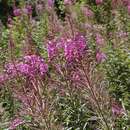Description
provided by eFloras
Stout erect perennial, forming large colonies by vigorous growth from a thick rootstock or by sprouting from spreading horizontal roots; stems simple, 30-250 cm, glabrous throughout or densely strigillose above. Leaves narrowly lanceolate or lanceolate, 2.5-20 x 0.4-3.5 cm, glabrous or sometimes with strigillose hairs on the abaxial midvein, obscurely denticulate, spirally arranged, subsessile or attenuate to short petiolate. Inflorescence a simple elongate lax raceme. Flowers drooping. in bud; ovaries densely white canescent, 10-18 mm, on pedicels 7-12 mm long. Sepals 9-13 x 1.6-2 mm, acute, canescent. Petals 12-15 x 7-8 mm, entire, deep pink or magenta or rarely white. Styles l0-20 mm long, initially sharply deflexed, becoming erect after anthers dehisce and reflex, longer than stamens. Stigma deeply 4-lobed and recurved, exserted beyond anthers. Capsules 4-7 cm long, on pedicels 0.7-1.5 cm long. Seeds 1-1.3 x 0.32-0.4 mm, surface irregularly foveolate, the chalazal collar short and inconspicuous; coma 9-12 mm long, white, not markedly deciduous. Chromosome number n = 18, 36, 54.
- license
- cc-by-nc-sa-3.0
- copyright
- Missouri Botanical Garden, 4344 Shaw Boulevard, St. Louis, MO, 63110 USA
Distribution
provided by eFloras
Distribution: Circumboreal, in North America south along the Cordillera to Mexico, throughout Europe to North Africa; and in Asia to Turkey, Iran, Pakistan and throughout the Himalayas to southern China.
- license
- cc-by-nc-sa-3.0
- copyright
- Missouri Botanical Garden, 4344 Shaw Boulevard, St. Louis, MO, 63110 USA
Habitat
provided by eFloras
This exceedingly widespread and variable species is common in the flora region. Two subspecies are recognized in North America (Mosquin, 1966) based on a combination of quantitative leaf and pollen characters, geographical range, and chromosome number. The diploid (with n = 18) subsp. angustifolium, with a more northern subarctic distribution, has smaller, glabrous leaves, and smaller triporate pollen. The polyploid (with n = 36, 54) subsp. circumvagum Mosquin is distributed farther south in the boreal forest zone, and has larger, sometimes pubescent leaves, and larger pollen, some of which is quadriporate. The pattern of variation in the Himalayan region is not so clearly defined, either geographically or morphologically, and there is no significant number of chromosome counts. It seems best, therefore, to treat this species in the Himalayan region without subspecific rank, at least until more critical studies have been carried out. Fl. Per.: Jul-Sep. Fr. Per.: Aug-Sep.
- license
- cc-by-nc-sa-3.0
- copyright
- Missouri Botanical Garden, 4344 Shaw Boulevard, St. Louis, MO, 63110 USA
Synonym
provided by eFloras
Chamaenerion angustifolium (L.) Scop., Fl. Carniol., ed. 2, l: 271. 1772; Shteinb. in Schischk. & Bobrov, Fl. URSS 15: 621. 1949; Wendelbo, Nytt. Mag. Bot. 1: 46. 1952; Epilobium spicatum Lam., Fl. Franc. 3: 482. 1778; Boiss., Fl. Or. 2: 745. 1872; H. LJv., Ic. Gen. Epil. t. 226. 1911; Chamerion angustifolium (L., em.) Holub, Folia Geobot. Phytotax. 7: 86. 1972.
- license
- cc-by-nc-sa-3.0
- copyright
- Missouri Botanical Garden, 4344 Shaw Boulevard, St. Louis, MO, 63110 USA

